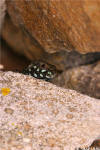



Reptiles
The island’s herpetofauna is typical of the Western Cyclades, where two endemic reptile species, the lizard Podarcis milensis and the viper Macrovipera schweizeri, are the most likely to be seen. These are among Greece’s rarest endemic vertebrates.
The lizard, Podarcis milensis, is restricted to Kimolos, Milos, Polyaigos and Antimilos. It is nearly 20 cm long. The males are vivid in colour with light blue spots during the reproductive period, while the females are brown. You can see lizards almost everywhere, particularly in the walls.
The viper, nicknamed ”therio” (monster), is limited to the islands Milos, Kimolos, Polyaigos and Sifnos. It is brown and grey and about one metre long. Its head does not have the characteristic ridge of other viper species. It is worth noting that it is a shy creature which will usually flee as soon as it senses a human presence. They are, however, venomous and you should be careful not to step on one by accident. They can even be deadly for young children or allergic people. During spring and autumn they lie on rocks in the sun, while in the summertime they spend most of the day hiding.
The impressive goustera (Lacerta trilineata hansschweizeri), is a large green lizard, which is found in humid bushy regions or marshland. Water snakes (Natrix natrix schweizeri) can also be found in small lakes and water tanks. This snake, as well as the other two species of snakes that live in the region (the Tellescopus fallax and the Eryx jaculus), are not venomous.


Birds
On the coastal cliffs of Polyaigos, Eleonora’s falcons (Falco eleonorae) build their nests. This falcon winters in Madagascar, while in the spring it migrates to the Mediterranean in order to breed. The young birds leave their nest at the beginning of August. It is estimated that 75% of the world population nests in the islands of the Aegean. The fate of this threatened bird of prey, therefore, is in our hands!
On the cliffs along the coasts of the two islands, nests of the shag (Phalacrocorax aristotelis), known also as “kalikatsou” are common. You may see this bird standing on the rocks in the sun with open wings to dry itself, or plunging into the sea, its long neck extended, to catch fish.
A rare species of eagle, the Bonelli’s Eagle (Hieraaetus fasciatus) nests on the heights of Polyaigos. While not classified as endangered on a world scale, its population is decreasing continuously and in Greece the number of recorded nesting pairs does not exceed 100. The Peregrine (falco peregrinus) and the Long legged Buzzard (Buteo rufinus) are also common on the two islands. Finally, particularly during the spring migration, several species of aquatic birds can be seen in small wetland areas.
